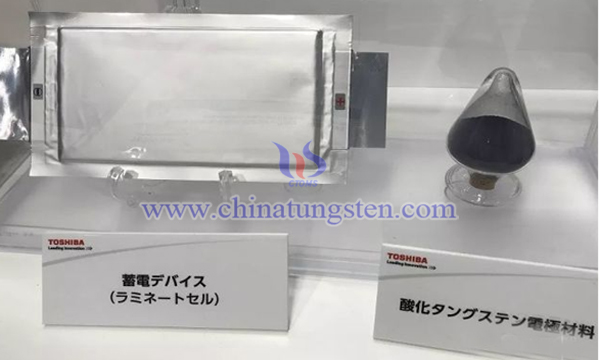Toshiba Is Developing an Ultra-fast Charging Lithium-ion Battery Using Purple Tungsten Oxide
- Details
- Category: Tungsten's News
- Published on Monday, 16 July 2018 18:42
At the just-ended Automotive Engineering Exhibition Yokohama 2018, Toshiba Materials exhibited an ultra-fast charging lithium-ion battery with a negative electrode material using purple tungsten oxide. Applications of the battery range from automotive, elevators, micro/mild hybrid vehicles, trains, uninterruptible power supplies (UPS), large current sources, to power supply stabilizer. It has an excellent and broad application prospects. As a leader in the field of lithium-ion battery technology, It is likely that Toshiba could probably put this new material into commercial use, which may further expand the demand for tungsten oxide.
It is reported that the new material have been developing by Toshiba uses tungsten oxide powder as an electrode material for new battery devices. The electron conductivity and lithium ion diffusion of tungsten oxide powder can be improved to achieve a ultra-fast charging and discharging. This material makes it possible to build battery devices with high power density, which enables a smaller and lighter device.
Precisely, Toshiba developed a new material called WO2.72, which is also known as the purple tungsten oxide in the industry. Purple Tungsten Oxide is a kind of tungsten oxide. Its appearance is finely divided, purple, crystalline powder. It is a tungsten oxide product developed by China in recent years. Its phase composition is W18O49. Due to its properties of largest mesopore volume, smallest micropores volume, narrowest pore size distribution, minimum fractal dimension, maximum average pore size and specific surface area. It is the preferred materials for making ultra-fine tungsten powder or nano-tungsten powder, photocatalytic materials, petroleum catalysts, and microelectronic integrated circuit boards.
The preparation process of purple tungsten oxide mainly includes APT wet hydrogen reduction method, Tungstic acid hydrogen reduction method, APT ammonia gas reduction method and etc. It is not clearly defined by Toshiba about its purple tungsten oxide preparation process. According to the official website of Toshiba Materials, purple tungsten oxide is highly chemically reactive, which enhances the electron conductivity. Since the material has a small internal resistance and excellent lithium ion diffusibility, the use of purple tungsten oxide as the battery negative electrode enables high-current charging and discharging. In particular, it has excellent discharge rate at low-temperature, and has a discharge rate equal to or higher than that of an Electrical Double Layer Capacitor (EDLC) even at -40 °C. In short, the low discharge rate of lithium-ion secondary batteries and lithium-ion capacitors at low temperatures has remained an unsolved problem.
The power density and energy density of the new Toshiba lithium-ion battery is 2 to 3 times over that of an EDLC. Li ion secondary batteries are not suitable for high-output applications due to insufficient output power and development difficulties. While the high power output property of the Toshiba lithium-ion battery will make it suitable to use in the field of high-output power applications.
As a leading business in the lithium-ion battery industry, Toshiba hopes to supply this new product as a battery material to other battery manufacturers after exhibiting its newly developed sample battery at the exhibition. The commercial potential of the new Toshiba battery is enormous. If promoted, tungsten materials could expand its market into the field of lithium-ion battery manufacturing.
- Tungsten Manufacturer & Supplier, Chinatungsten Online: www.chinatungsten.com
- Tungsten News & Prices of China Tungsten Industry Association: www.ctia.com.cn
- Molybdenum News & Price: news.molybdenum.com.cn
- Tel.: 86 592 5129696; Fax: 86 592 5129797; Email: sales@chinatungsten.com



 sales@chinatungsten.com
sales@chinatungsten.com